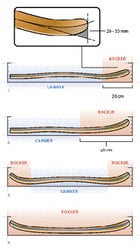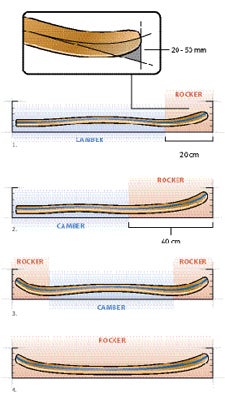For years, skis and snowboards simply had camber, a tip-to-tail arch that distributed weight for glide and helped drive you across the hill by returning energy to your edges. Camber worked great on hardpack but demanded exhausting weighting and unweighting in powder. Enter the age of rocker. By flipping the camber upside down, rocker turns skis and snowboards into powder flotation devices, the weight/unweight no longer necessary. There are other benefits, too. For skiers, a hint of tip rocker lets you roll today’s fatter skis into turns with far less knee-driving effort. For snowboarders, turn initiation is similarly easier, as is jibbing. What is less straightforward is making sense of all the various kinds of rocker and new terminology that now exist. What does it mean? Which style is right for you? Here’s a primer.
Rocker Sizing
For snowboards, size normally. Skis are (a bit) different. The so-called “shortening” effect (see Early Rise, above) can be more pronounced in skis than it is with snowboards—and many people assume you should buy rockered skis in a slightly longer size than you would customarily. But it’s not that simple. Roll a rockered ski onto its edging angle and the effective running length grows to the length of the ski.A rule of thumb: Consider going one size up with banana-shaped skis but not with subtly rockered boards.
Skiing and Snowboarding
 Rocker vs. Camber
Rocker vs. Camber1. EARLY RISE
Definition: Subtle rocker in the tip of the ski or board, but after that everything is normal in terms of camber and sidecut.
The benefit: Early rise “shortens” the effective running length of a board’s edges, making it easier to initiate turns. Expect a slightly looser feel in powder, but because the edges still engage at low angles the best application is in all-mountain skis designed to carve a full turn and handle variable terrain.
2. TIP ROCKER
Definition: Like early rise, only exaggerated.
The benefit: Big-time float, nearly effortless turn initiation. You lose a little edging grip in the tip, but the (often flat) tail finishes the turn with power. The best application is in big-mountain snowboards and skis.
3. TIP AND TAIL ROCKER
Definition: Rocker (from subtle to severe) in the tip and tail, but with traditional camber that runs from just in front of the bindings to just behind them. (Note: Some snowboards, like the Lib Tech, have the exact opposite profile: traditional camber in the tip and tail, and rocker underfoot.)
The benefit: In powder you get a loose and surfy feel because the tail releases so easily, but on hardpack, if you have good form and stay balanced, you can still edge out turns. Resort riders with a centered stance and an undying love for powder should look here.
4. FULL ROCKER
Definition: Usually flat—no camber either way—underfoot, with varying degrees of rocker in the tip and tail. (These are the skis and snowboards that resemble bananas.)
The benefit: This is the ultimate in loose and playful riding. The boards are easy to pivot and slough through soft snow. But they’re not exclusively jib-inspired powder pigs. If the rocker is subtle, skilled riders can crank out surprisingly clean carved turns on fully rockered boards.


